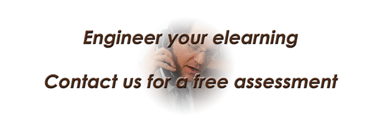If you have a skill you would like to teach to others, how do you start? You probably do not have experience teaching in a classroom, it is then a long stretch to assume you could teach online. But others are doing that, despite the lack of experience, and they may claim they are successful (there is room for an argument there). So how can you learn it? Fortunately, there are many resources on the Internet, both free and paid. If you can afford it, enroll in an online teaching certification program, you can also hire a coach that can help you with this process, or just learn it on your own.
You can start by recording yourself teaching and uploading the video to a free service such as YouTube or Vimeo, then you can distribute the video to people willing to give you some feedback, from there you can make a lot of improvements. You may upload your slide deck to Slideshare and distribute the link to others that can also help you with some feedback. Once you are comfortable teaching in front of the camera, you may want to take the next step and arrange your first live class.
But how do you conduct a webinar? If you want a quick way to start, you may want to start by reading my previous post on how to conduct successful webinars. You may have already attended one, if you have not, what is wrong with you? Have you lived under a rock these past ten years? Webinars are the preferred tool to communicate with live video with others, many trainers use this tool because it is affordable, the technology has matured to a point where technical glitches are rare, and many of the companies offering this service also offer the ability to record the event. This means you will be able to export the video, which you can re-purpose, as I explained in this previous post.
After you converted that webinar into a video you should watch it again and ask yourself, honestly, if you could learn anything from it. You will probably conclude the video is as good as a draft product, in beta version. You may need to repeat this process a couple of times, the third version of the video may be a product that you can use to teach your eLearning course asynchronously (that is, your learners will be able to access it on demand). But will that video, on its own, be an eLearning course? Short answer is no. But it can be converted into one. It will require more planning and work but you will end up with an eLearning course that you can market as a true learning experience.
One thing you need to do before you even start planning the webinar is determining the objectives of your course. What do you expect the learners to know at the end of the course? Which ability do you expect them to master at the end of the module? Are you expecting a change in behavior? Do you need them to learn a process? You will have a clearer picture of how your course is going to look after you finish this exercise. The next big task is not even the planning of the webinar. You need to determine how you will measure they successfully achieve the objectives you set for the course. With no measurement of achievement, your course will only be a nice recorded webinar, the objectives is a nice thing to have at the beginning of the video but what will bring the point home is this last part.
There are many ways to accomplish this. You may end the video with a quiz, or you can integrate quizzes within the video and collect the results to determine if the learner passed the course. You may require they submit a written assignment, you may want to know how they would apply what they learned in the course through writing. It could be a research project they need to submit. You could also require a video submission (that would be cool), which they can do with their mobile devices. One testing tool extensively used in training is case studies. You may develop some for practice and then give one final case for the passing grade. This is the best reason to take on an online teaching certificate or to pay a coach to guide you through these steps. I cannot stress more how important this part of your course development is for your final goals.
You will spend a lot of time trying to figure out the best tool that will launch your course towards success. It is not that you will have few options, you will be overwhelmed by the options available out there. There are solutions for big and small players. There are cheap solutions (which will get you so far), there are the more expensive ones (suitable for the big enterprise), be careful when choosing the technology because you could go overboard in making an expense you did not need. One approach would be to talk to others that are already doing something similar. You will probably find that others are using the following:
- A WordPress site
- Webinar tools such as GoToWebinar
- LMS services (if they can afford it)
- Pre-built websites with video streaming capabilities
- Course vendors such as Udemy
But in the early stages you will do fine by using a webinar tool and a place where to host your course. Don’t spend a lot of time researching the technology. Do spend as much time as you can developing your course.
I have taken two online courses on traffic rules (mandatory for a discount on a traffic ticket, don’t ask), to this day I just cannot understand how I survived them, let alone how on earth I was able to pass both. They were awful, basically a bad product (although they were cheap, that’s not an excuse) that anybody would dread to face. Do you want people to say the same things about your course? If I just pay for your course and in exchange I get a long video you recorded as a webinar, I may just shrug off and watch the video until tears come out of my eyes out of boredom. You bet I will not recommend your product to anyone I know, you can bet I will just put that expense in the list of “lame things I bought”. That’s just me. Others may go a step further and give you an earful because they will feel ripped off. The big investment in an eLearning course is not the expense for technology, it is the time you put in developing materials for it, in the planning you need to do before you move on to the next step. But it will be worth at the end, once you do it the first time, it will be easier the second time around.
As always, find us in social media. You can share this content by using the buttons below. If you have questions and comments, use the form at the bottom of this page, or contact me directly, and I will get back to you as soon as I can. Thank you for reading this post.


Pingback: ELearning in Motion – Conducting Successful Webinars for eLearning